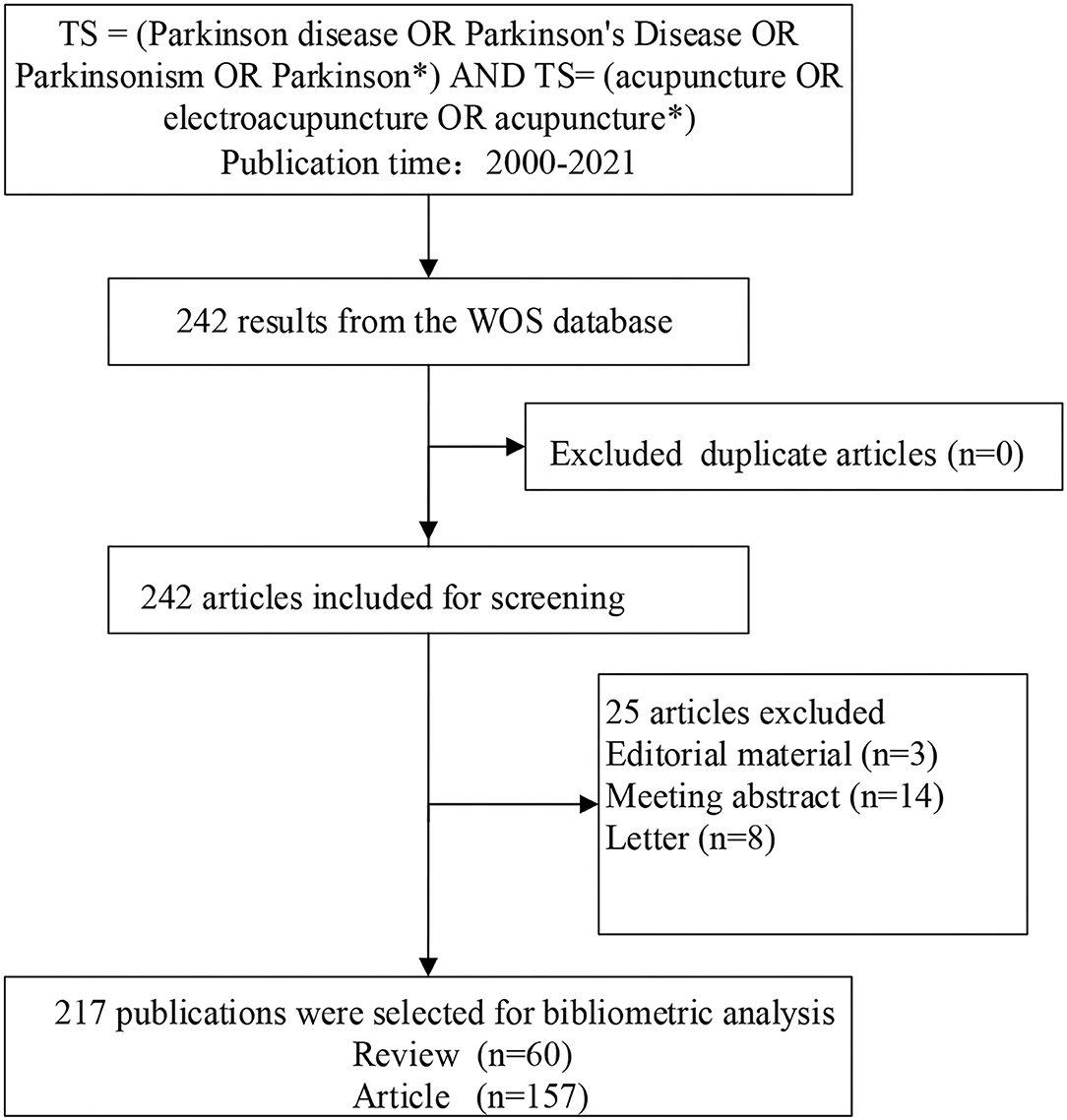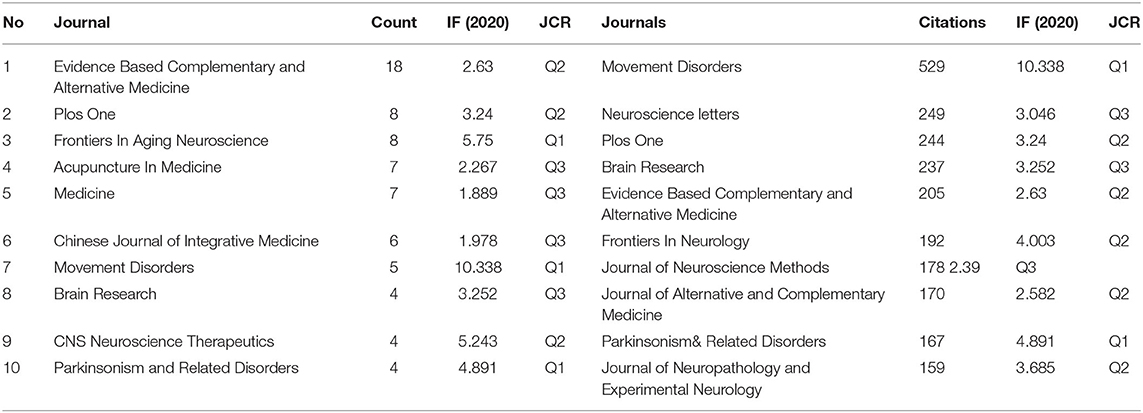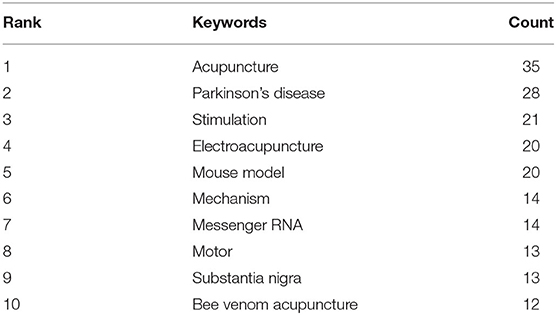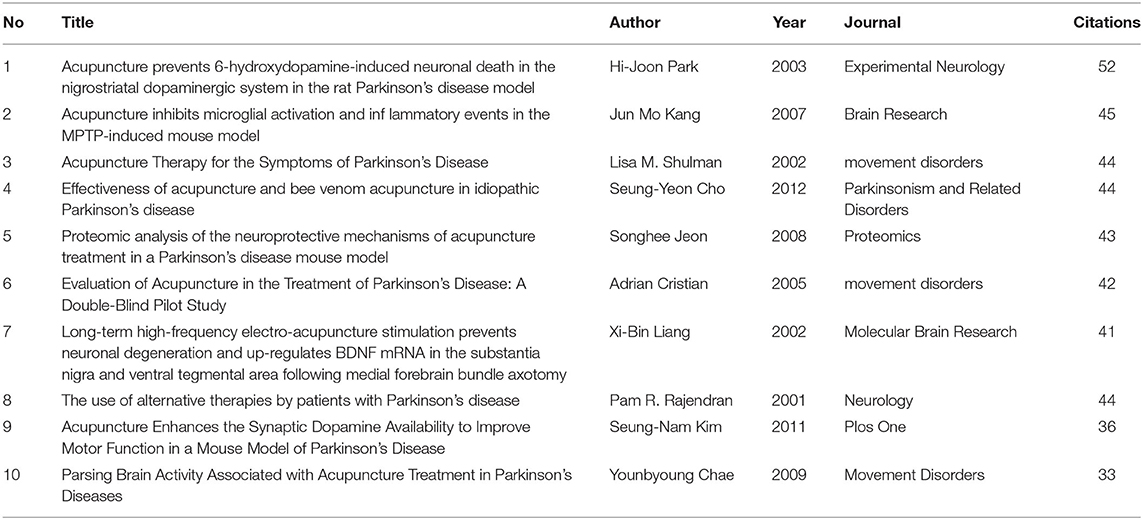- 1The Third Clinical Medical College of Zhejiang Chinese Medical University, Hangzhou, China
- 2School of Acupuncture-Moxibustion and Tuina, Shanghai University of Traditional Chinese Medicine, Shanghai, China
- 3Innovation Research Center of Acupuncture and Medicine, Shaanxi University of Chinese Medicine, Xianyang, China
- 4Shaanxi Key Laboratory of Acupuncture and Medicine, Xianyang, China
Background: Acupuncture has been widely used in the treatment of patients with Parkinson's disease (PD) in the world. Despite we have an in-depth understanding of acupuncture in this field over the past years, there is no available literature on bibliometric analysis on the development of acupuncture on PD. This study was designed to explore the global trend in the research of acupuncture on PD in the recent 20 years by the software CiteSpace (5.8.R3) and VOSviewer (1.6.14).
Methods: Publications regarding acupuncture therapy for PD from 2000 to 2021 were retrieved from the Web of Science Core Collection database. CiteSpace and VOSviewer were used to analyze the number of publications, the contribution of countries, institutions, journals, authors, references, and keywords.
Results: A total of 217 studies were extracted from the database. The outputs of the publications in this field showed an upward trend during the past two decades. The country and institutions with the most publications in this field are China, South Korea, and the USA. They were the main contributors to the research. Kyung Hee University and Capital Medical University were the two most productive organizations. Hi-Joon Park had made the greatest contributions to the field. Evidence-based Complementary and Alternative Medicine was the most popular journals in this field. “Electroacupuncture” and “Bee venom acupuncture” were emerging research hotspots.
Conclusion: The research on acupuncture on PD is potential. Authors from different countries/regions and organizations need to remove the language and academic barriers to enhance global cooperation and communications. Scholars in this field need to publish their research findings in high-quality journals to gain more attention worldwide. This study indicated that the mechanism leading to the non-motor symptoms of PD, the establishment of appropriate models that fully reflects the non-motor features of human PD, and the efficacy and safety of promising therapies for patients with PD will remain research frontiers in the future.
Introduction
Parkinson's disease (PD) is recognized as the second most common neurodegenerative disease with clinical features such as postural instability, resting tremor, bradykinesia, and rigidity (1). These motor symptoms are the main clinical criteria leading to the diagnosis of PD (2). However, patients also suffer from non-motor symptoms that seriously challenge their living quality in the early phase of the disease (3). Therefore, both the motor symptoms and non-motor symptoms are the concerns for patients with PD. The incidence of PD is high and increases rapidly after the age of 50 years (4), which brings a huge economic and medical burden to society (5, 6).
Acupuncture, a traditional treatment with few side effects from China 2,000 years ago, is used for different kinds of diseases worldwide (7, 8). It has been reported that around 40% of patients in the USA take complementary and alternative medicine when they deal with their illness. In South Korea, this can be as high as 76% (9, 10). Acupuncture is an essential complementary component to the drug therapy for PD (11). The mechanisms of the effectiveness of acupuncture for the treatment of PD remain uncertain, though an increasing number of studies revealed acupuncture's therapeutic effects both in clinical and animal experiments research for PD (12–15).
Bibliometric analysis is performed with visualization tools to analyze the numerous published academic literature, which has advantages over other conventional research methods, such as study review, meta-analysis, and experimental or clinical research, which are not able to reach the same depth analysis results (16–20). With the help of visualization applications, namely, CiteSpace and VOSviewer software, bibliometric analysis can qualitatively and quantitatively explore the contribution of authors, countries/regions, institutions, and their cooperation relationships. More importantly, bibliometric analysis can point out the hotspots and frontiers and also predict the development trends of a specific field, which could be an important indicator for the following research in the future (21, 22).
Studies have revealed the therapeutic effect of the treatment of acupuncture for PD over the past 20 years (23, 24). However, there is no research on the bibliometric analysis of the global development of acupuncture on PD. It is important to understand the global trend in the research and development of acupuncture treatment for PD. This study was designed to explore the development of acupuncture for PD worldwide based on the Web of Science Core Collection (WoSCC) database, including clinical research and animal experiments from 2000 to 2021. The global research trends and topic hotspots will be reflected by identifying the core authors and their research cooperation relationships, institutions, countries and regions, and network analysis of keywords.
Methods
All the data were extracted from the Web of Science Core Collection database based on the requirements of CiteSpace and VOSviewer software. The Web of Science Core Collection database was selected for this study for its wide range of comprehensive literature and high citation rates. The following search strategy was used in this study to generate the search result: “TS = (Parkinson disease or Parkinson's disease or Parkinsonism or Parkinson*) and TS = [Acupuncture or Electroacupuncture (EA) or Acupuncture*],” with the publication time from 2000 to 2021. The document type was limited to articles and reviews, without limitation of the language.
Two authors (LXP and WW) retrieved the publications and assessed the articles independently. Any uncertainty about the eligibility of the article will be consulted by a third reviewer (WQ). The VOSviewer and CiteSpace were applied to conduct the analysis. The analysis of the annual publications, the top countries/regions, institutions, authors, journals, and keywords were performed in the results of the network visualization. The parameter of the VOSviewer was set as follows: Method (LinLog/modularity). The parameters of CiteSpace were set as follows: Method (LLR), time slicing (2000–2021), years per slice (1), term source (all selection), node type (choose one at a time), selection criteria (top 50 objects), and pruning (pathfinder).
Results
Analysis of Annual Publications
There are 217 publications (157 articles and 60 reviews) that were collected from the WoSCC database in this study (Figure 1). The output of the publication grew slowly and showed fluctuations from 2008 to 2014. After 2015, the annual publication showed an upward tendency with more than 15 papers published each year. Notably, the output of 2020 was more than twice that of 2019 and reached its peak with 33 articles (Figure 2).
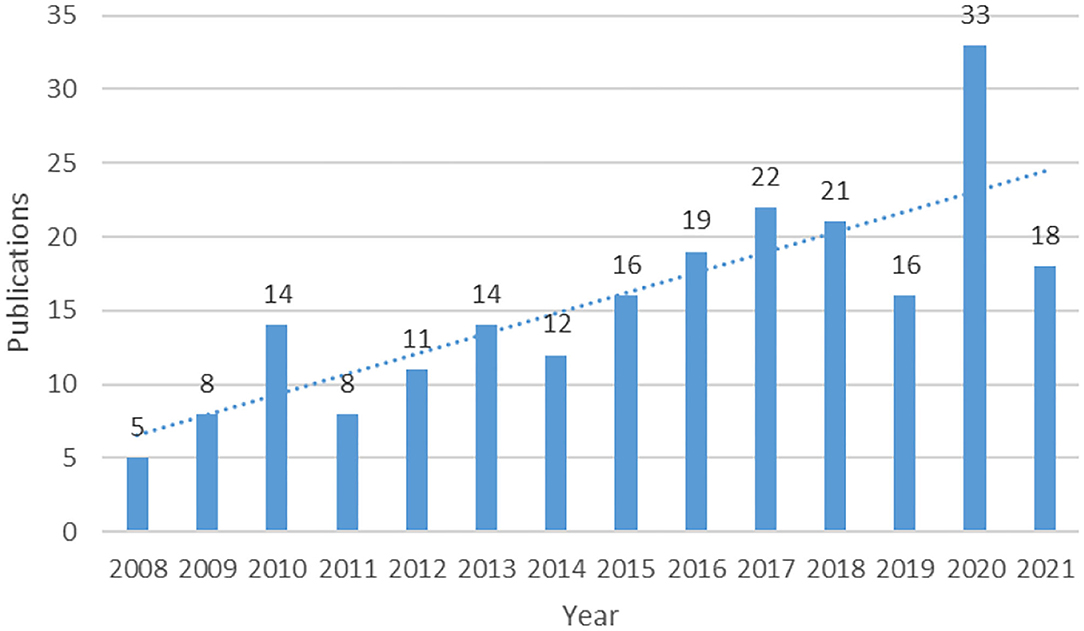
Figure 2. The number of annual publications on acupuncture treatment for Parkinson's disease (PD) from 2000 to 2021. The horizontal coordinate represents the different years and the vertical coordinate represents the single-year publication number.
Analysis of Countries/Regions
A total of 34 countries/regions were involved in the publications of PD treated by acupuncture. China (101, 46.5%), South Korea (68, 31.3%), the United States (39, 17.9%), England (8, 3.7%), and Egypt (7, 3.2%) were the top five countries/regions in terms of the number of publications (Figure 3). The documents from China were almost half of the total. The countries/regions with the top three total link strengths were China, the United States, and South Korea, which mean that they had more cooperation with other countries (Table 1). Those three countries also had the largest number of citations when ranked by citations. Those three leading countries/regions made great contributions to this field.
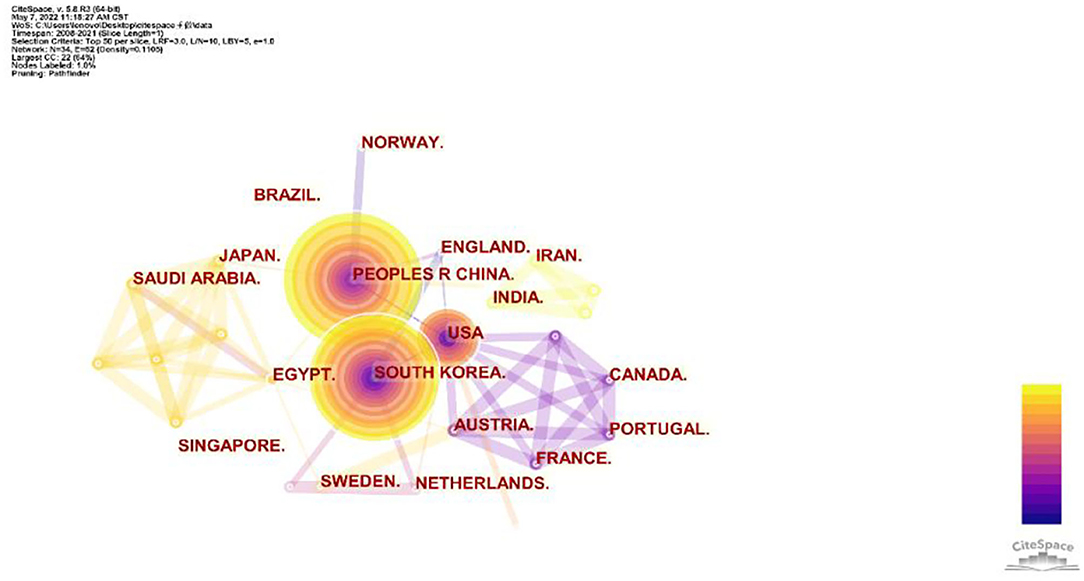
Figure 3. Network map of countries/regions from Citespace. Each node represents a country/region and the size of the node presents the number of publications of that country/region. Connections between nodes present the collaborations between the regions/countries and the thickness of the lines indicates the strength of the relationship. The purple ring in the inner circle represents the publications from the earliest year and the yellow ring in the outer circle is the most recent publications.
Analysis of Institutions
According to the results of the analysis, 303 institutions were concluded to research of acupuncture on PD (Figure 4). Kyung Hee University has the largest number of publications (49, 22.5%), followed by Capital Medical University (24, 11%), China Medical University (13, 5.9%), Korea Institute of Oriental Medicine (13, 5.9%), China Medical University Hospital (11, 5%), and Pusan National University (11, 5%). The top 10 institutions with the greatest number of cited times are given in Table 2. Kyung Hee University was the most cited institution (1,033), followed by Capital Medical University (454) and Pusan National University (240). Institutions with the leading three link strengths are Kyung Hee University, Capital Medical University, and China Medical University. These institutions had more cooperation than other institutions.
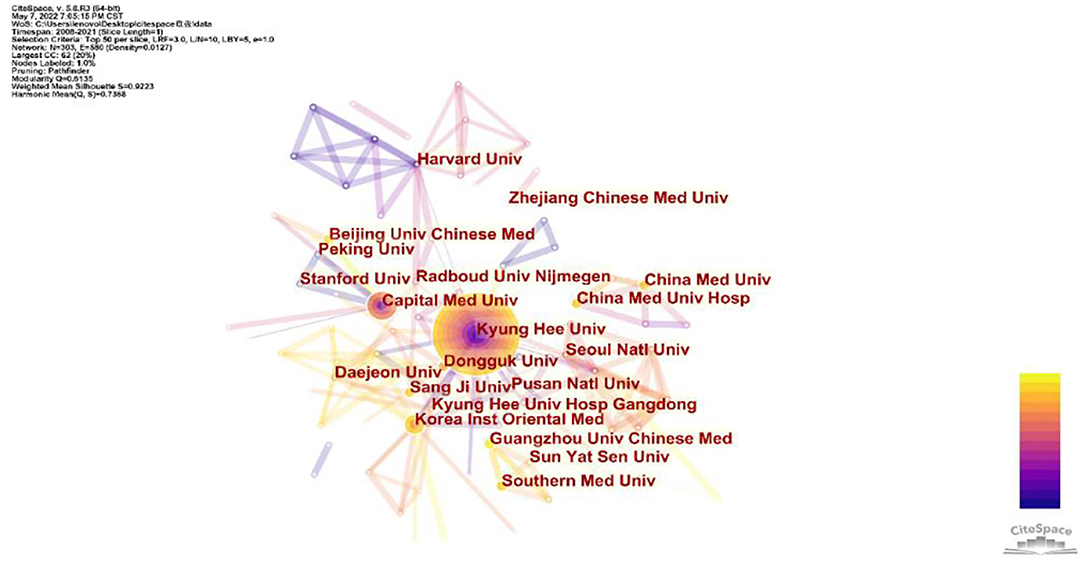
Figure 4. Network map of institutions from Citespace. Each node represents an institution and the size of the node presents the number of publications of that institution. Connections between nodes present the collaborations between the institutions and the thickness of the lines indicates the strength of the cooperation. The purple ring in the inner circle represents the publications from the earliest year and the yellow ring in the outer circle is the most recent publications.
Analysis of Authors and Co-cited Authors
A total of 1,000 authors with 217 publications were involved in the field. Park Hi-Joon from Kyung Hee University in South Korea published the largest number of articles, followed by Xiaomin Wang from Capital Medical University in China and Sabina Lim from Kyung Hee University in South Korea (Table 3). They were the leading contributors to the publications in this field. Park Hi-Joon (592 citations) was the most cited author, followed by Hyejung Lee (379 citations), Coelho Miguel (372 citations), and Fox Susan H (372 citations). Park Hi-Joon was the most productive author with the largest number of publications and citations, which suggested that the studies of Park Hi-Joon in this field have been recognized by scholars (25–27). Co-cited authors are those two or more authors that are cited together in one publication and they build a co-citation relationship. Seung-Nam Kim (77) was the most frequently co-cited author, followed by Liang XiBin (74). There is an obvious cooperation network between different scholars, for example, Park Hi-Joon, Jung Woo-Sang, and Seung-Yeon Cho.
Analysis of Journals and Co-cited Journals
A total of 116 academic journals were involved in the studies of acupuncture for PD. Evidence-based Complementary and Alternative Medicine contributed the largest number of publications (18, 8.2%) and Movement Disorders had the highest impact factor among the top 10 journals (IF = 10.338) (Table 4). Co-citation analysis of journals is to identify the journals with notable influence in a domain. Movement Disorders had the highest level of co-citations (529), followed by Neuroscience Letters (249), which demonstrated that Movement Disorders had an important position in this field. According to the Journal Citation Report (JCR) 2021 standards, three of the top 10 journals were categorized as the first quartile (Q1), three of the top 10 journals belonged to the second quartile (Q2), and four of the top 10 journals belonged to the second quartile (Q3). The top 10 journals were the mainstream journals in this field.
Analysis of Keywords
The result of the keyword analysis helps to find research hotspots and predicts developing trends in a field. The top five most frequent keywords are acupuncture (35), Parkinson's disease (28), stimulation (21), electroacupuncture (20), and mouse model (20) (Table 5). As shown in the network map (Figure 5), the identified keywords can be divided into five clusters: acupuncture and bee venom acupuncture (BVA) (in red), electroacupuncture and neuroprotection (in green), alpha-synuclein and gene expression (in blue), cell death and mouse model (in yellow), and functional MRI (FMRI) and mechanism (in purple). Citation burst offers assistance to identify the hot words at the frontier of research within the entire analyzed period. The top five keywords with the strongest citation bursts were: Non-motor symptom (3.2), bee venom acupuncture (2.43), rat (2.37), electroacupuncture stimulation (2.11), and motor (2.04) (Figure 6).
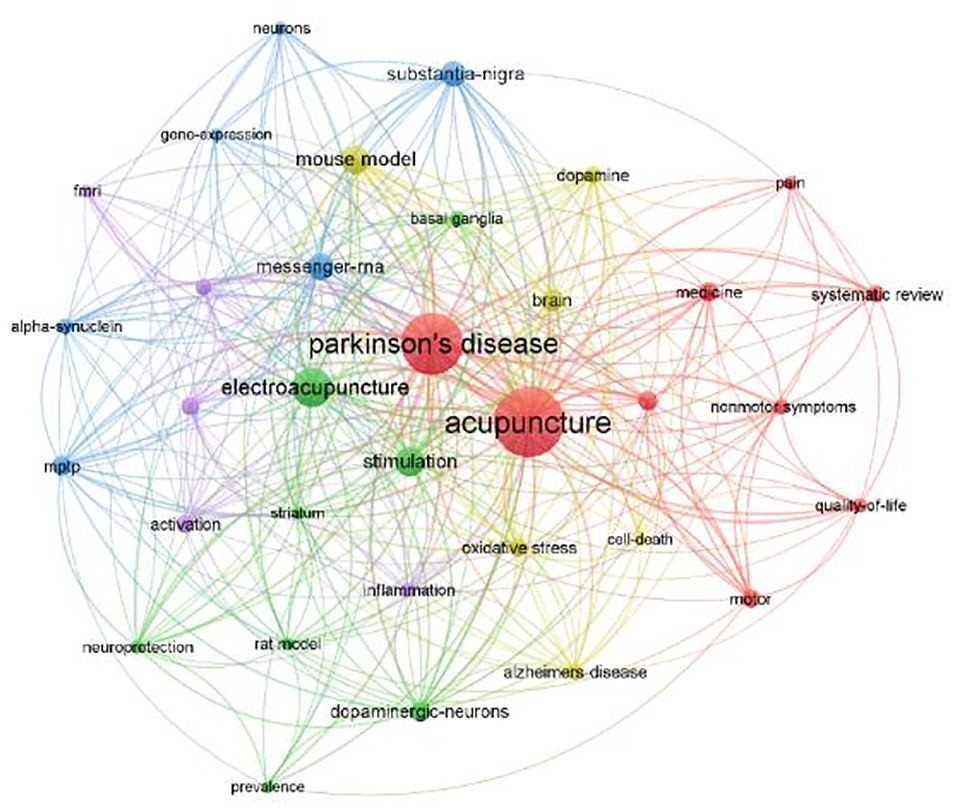
Figure 5. Network map of clustering keywords from VOSviewer. Each node represents a keyword and the size of the nodes represents the frequency of occurrences. The color of the nodes distinguishes the cluster of the keyword.
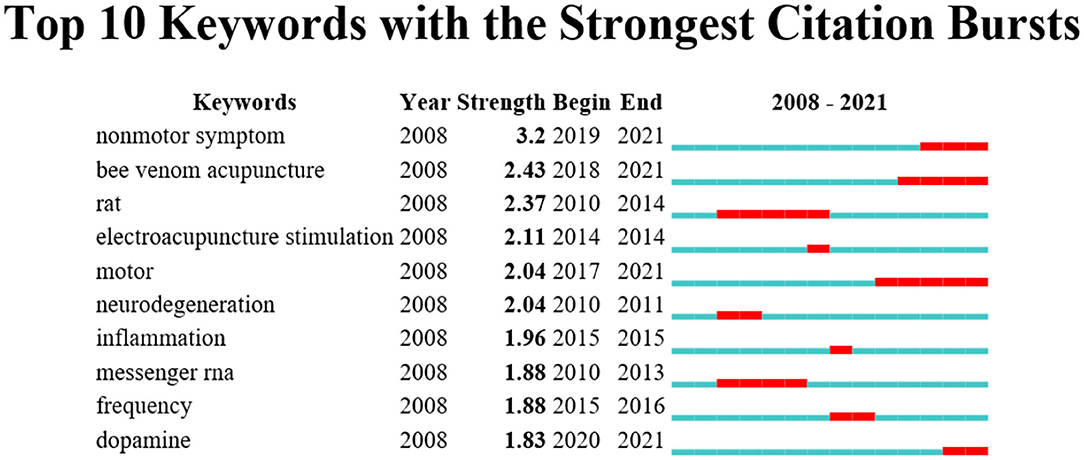
Figure 6. Top 10 keywords with the strongest citation bursts by CiteSpace. The beginning of a blue line represents when an article is published. The beginning of a red mark is the beginning of a period of burst and the end of the red mark is the end of the burst period.
Analysis of Citations
The co-citation analysis of references helps to identify the most frequently cited references and measures the relationships between references. Table 6 shows the top 10 most frequently co-cited references. The article published by Hi-Joon Park in Experimental Neurology had the largest number of citations (52), followed by the article published by Jun Mo Kang in Brain Research (45) and the article published by Lisa M Shulman in Movement Disorders (44). These references had a great influence on the treatment of acupuncture for PD. Publications with strong citation bursts had great influence in a field. Figure 7 presents the top 10 references with the strongest citation bursts.
Discussion
The number of annual publications is an important indicator to identify the general information of the most influential countries/regions, institutions, authors, and journals in the bibliometric analysis. The frequency of publication gradually increased from 5 publications in 2008 to 33 in 2020. The overall number of publications about acupuncture on PD showed an upward trend during the past two decades indicating that research on acupuncture on PD has got great attention from researchers, clinicians, and patients.
According to the analysis of the countries and organizations, China, South Korea, and United States were the leading countries in terms of the number of publications and citations. The documents from China were almost half of the total. If the database that we searched was extended to Chinese-based databases, China would have more published articles since acupuncture originated in China. China is the largest contributor and world leader in the research of acupuncture for PD. Kyung Hee University (South Korea) and Capital Medical University (China) were the top two organizations with the maximum number of publications and citations. It suggested that organizations from South Korea have made great progress during the past two decades. As shown in Figures 3, 4, the international cooperation of academic research between the top three productive countries has not yet been formed. Most collaborations of the publications were from domestic organizations. Therefore, the international cooperation of organizations from different countries needs to be strengthened to enhance the global development of acupuncture.
As for the analysis of authors and co-cited authors, Park Hi-Joon, from the Acupuncture and Meridian Science Research Centre of Kyung Hee University in South Korea, is the leading contributor in this field with the largest number of publications, citations, and cooperation, which indicate the outstanding studies he and his team had devoted during the past 20 years. As shown in Table 3, authors from South Korea had more cooperation with the domestic authors; however, the international cooperation of authors was not ideal. Therefore, authors worldwide should remove the language barriers to improve global cooperation in this field.
From the perspective of journals and co-cited journals, studies on acupuncture for PD are more popular in the journal of Evidence-based Complementary and Alternative Medicine, which is focused on the therapy of Traditional Chinese medicine. Movement Disorders had the highest number of co-citations and the most cited references were from high-quality journals, suggesting that scholars need to expand their choices to publish the research findings in high-quality journals, which help to gain more attention about acupuncture for PD worldwide.
As for the co-citation analysis of references, the most frequently co-cited article was published by Hi-Joon Park in Experimental Neurology in 2003 (52), which reported the neuroprotective effects of acupuncture.
The most frequent keywords are Acupuncture (35), Parkinson's disease (28), Stimulation (21), Electroacupuncture (20), Mouse model (20), Mechanism (14), Messenger RNA (14), Motor (13), Substantia nigra (13), and Bee venom acupuncture (12). The identified keywords can be divided into five clusters. The top five keywords with the strongest citation bursts were: non-motor symptom (3.2), bee venom acupuncture (2.43), rat (2.37), electroacupuncture stimulation (2.11), and motor (2.04). Based on the co-occurrence and the cluster analysis and the citation bursts of the keyword, we determine the academic hotspots and frontiers in this field.
Clinical Manifestations of Parkinson's Disease
Parkinson's disease (PD) is recognized as the second most frequent neurological disease after Alzheimer's disease (28). The neuropathology hallmark of PD is the loss of dopaminergic neurons in the substantia nigra pars compacta (SNpc) and the presence of Lewy bodies (LBs), which are mainly composed of α-synuclein (α-Syn) (5, 29). Most of the LBs aggregates in the SNpc, however, are also found in the autonomic and peripheral nervous systems, which may be associated with the occurrence of some non-motor symptoms. Parkinson's disease is clinically characterized by the movement disorders such as postural instability, resting tremor, bradykinesia, muscle weakness, and muscular rigidity (30). However, non-motor symptoms from multisystem, namely, the impairments of gastrointestinal (GI), respiratory, genitourinary, cardiovascular, neuropsychiatric, sensory, skin, visual, pain, and other systems, not only challenge the patient quality of life, but also deteriorate the motor symptoms of PD (31, 32). Different from the motor symptoms, which become apparent when 50–70% of dopaminergic neurons in the central nervous system (CNS) already degenerate, some non-motor symptoms have been reported to occur up to 10 years before the clinical diagnosis (33). In contrast to the motor symptoms of PD, for which meditation is available and effective in clinical studies, non-motor symptoms are always poorly recognized and non-responsive to anti-PD meditations treatment even undertreated. Most of the drugs for PD treatment always cause non-motor symptoms as adverse effects, especially in elderly patients. However, non-motor symptoms of PD started to get more and more attention from clinicians, patients, and researchers, which offer adequate treatments for patients with PD to improve their quality of life and extend life expectancy. Recent research has paid more attention to the non-motor symptoms compared to the previous research that focused more on the motor symptoms. However, the etiology of non-motor dysfunctions in PD has not been fully understood. To better understand the potential mechanism of the non-motor manifestations and explore effective treatments, more and more animal models are emerging to investigate the efficacy and safety of promising therapies. However, no ideal animal model has been agreed upon for PD research (34). It is difficult to establish an appropriate model that fully reflects the non-motor features of human PD.
Mechanisms of Acupuncture for Parkinson's Disease
Increasing evidence showed that acupuncture has potential effects on patients with PD to alleviate their motor and non-motor symptoms (15, 35). We summarized the possible mechanisms of acupuncture about how to exert protective effects on dopaminergic neurons: (1) Acupuncture could inhibit the increase of α-syn and accelerate the clearance of α-syn to reduce the abnormal aggregation of α-syn. Yeo et al. found that acupuncture at GB34 and LR3 upregulated serum/glucocorticoid-regulated kinase 1 (SGK1) and inhibited an α-syn production (36). Tian et al. (37) observed that microtubule-associated protein 1 light chain 3 II (LC3II) and lysosomal-associated membrane protein 1 (LAMP1) were reduced and more than 50% of α-syn in the SNpc was cleared after the treatment of acupuncture 4 days, suggesting that acupuncture at GB34 enhances degradation of α-syn and the clearance of autophagosomes. (2) Acupuncture inhibits the apoptotic pathways, thus promoting the survival of dopaminergic neurons. MA and acupoint injection at ST36 have been proven to inhibit the apoptotic pathway by downregulating the apoptotic markers such as Bax, cytochrome C, and upregulating B-cell lymphoma-2 (Bcl-2) (38). (3) Acupuncture can reduce the oxidative stress response of PD to protect the dopaminergic neurons. Yu et al. (39) proved that acupuncture could increase the levels of intracellular antioxidants such as superoxide dismutase (SOD), glutathione (GSH), and glutathione peroxidase (GSH-Px) and decrease the levels of malondialdehyde (MDA) to improve the rotarod behavior of PD. (4) Acupuncture could improve the movement disorders of PD by inhibiting the activation of microglia cells and normalizing the neuroinflammatory factors (34, 40). (5) Acupuncture could recover the homeostasis of the transmission of dopaminergic neurons in the basal ganglia circuit and attenuate dopaminergic neuronal loss (41, 42).
Electroacupuncture
Electroacupuncture got more and more attention recently (43–45). Especially, in the clinical treatment, the electrical stimulation for 20 min always achieves a better clinical effect than the manual stimulation that needles are twirled or lifted and thrusted by hands for a few seconds during the 20 min treatment time. However, there are very few clinical trials that take the EA and manual acupuncture (MA) for comparison and the publications of the meta-analysis always conclude the clinical trials of the acupuncture without distinguishing between the electrical and the manual stimulation models. The frequency, intensity, and duration of the electrical and manual stimulation are mostly based on the patient's condition and it is quite difficult to make the parameters conform to the same standard in clinical trials. However, the comparison between the EA and the MA is easier to operate in the experimental research because the parameters of the stimulation, namely, the frequency, intensity, and duration, are quantifiable in the animal models in the experimental studies. To identify that the electric current was the only reason for the different clinical effects between these two stimulations (46), more and more well-designed clinical trials should be developed and applied when comparing EA vs. MA.
Bee Venom Acupuncture
Bee venom acupuncture is a new treatment of acupuncture that injects the diluted bee venom into the acupoint or applies the bee venom on the tips of acupuncture needles. Bee venom consists of multiple substances, especially proteins and peptides, which have the effects of anti-inflammatory, antioxidant, neuroprotective, and antitumor. BVA has been used to relieve a range of pain conditions such as lumbar disk disease, osteoarthritis of the knee, and rheumatoid diseases. BVA can also alleviate neurological conditions, namely, peripheral neuropathies, stroke, and Parkinson's disease (47, 48). The clinical trial of BVA for idiopathic Parkinson's disease conducted by Cho et al. (49) concluded that BVA significantly improved motor symptoms in patients with PD. BVA treatment also reported the neuroprotective effect by normalizing all the neuroinflammatory and apoptotic markers and restoring brain neurochemistry in rotenone-induced PD mice models (50). However, there are certain problems regarding its safety and the possible appearance of adverse effects. Therefore, practitioners of bee venom therapy should be cautious when applying it in daily clinical practice.
Conclusion
This study unveiled the research status of acupuncture on PD during the past two decades. Publications in this field were on the rise over time. The authors from different countries/regions and organizations need to remove the language and academic barriers to enhance global cooperation and communications. Most articles were published in journals, which are focused on the treatment of Traditional Chinese medicine, indicating that scholars need to publish the research findings in high-quality journals to gain more attention worldwide. This study also helps scholars to identify the influential journals for publication. Some issues remain unsolved, such as the mechanism leading to the non-motor symptoms of PD, the establishment of appropriate models that fully reflects the non-motor features of human PD, and the efficacy and safety of promising therapies for patients with PD. Those questions need to be put on the agenda, which offers assistance for the scientists to explore the new directions in further studies.
Data Availability Statement
The original contributions presented in the study are included in the article/supplementary materials, further inquiries can be directed to the corresponding author/s.
Author Contributions
All authors listed have made a substantial, direct, and intellectual contribution to the work and approved it for publication.
Funding
This study was financially supported by the National Natural Science Foundation of China (Grant No. 81873388).
Conflict of Interest
The authors declare that the research was conducted in the absence of any commercial or financial relationships that could be construed as a potential conflict of interest.
Publisher's Note
All claims expressed in this article are solely those of the authors and do not necessarily represent those of their affiliated organizations, or those of the publisher, the editors and the reviewers. Any product that may be evaluated in this article, or claim that may be made by its manufacturer, is not guaranteed or endorsed by the publisher.
Acknowledgments
The authors would like to express their appreciation to Prof. CM Chen, who invented CiteSpace for free use.
References
1. Ascherio A, Schwarzschild MA. The epidemiology of parkinson's disease: risk factors and prevention. Lancet Neurol. (2016) 15:1257–72. doi: 10.1016/S1474-4422(16)30230-7
2. Isaacson SH. Early recognition and diagnosis of parkinson disease and ongoing assessments. J Clin Psych. (2019) 81:4088. doi: 10.4088/JCP.MS18003BR1C
3. DeMaagd G, Philip A. Parkinson's disease and its management: part 1: disease entity, risk factors, pathophysiology, clinical presentation, and diagnosis. PT. (2015) 40:504–32.
4. Bower JH, Maraganore DM, McDonnell SK, Rocca WA. Influence of strict, intermediate, and broad diagnostic criteria on the age- and sex-specific incidence of parkinson's disease. Mov Disord. (2000) 15:819–25. doi: 10.1002/1531-8257(200009)15:5<819::AID-MDS1009>3.0.CO;2-P
5. Kalia LV, Lang AE. Parkinson's disease. Lancet. (2015) 386:896–912. doi: 10.1016/S0140-6736(14)61393-3
6. Lees AJ, Hardy J, Revesz T. Parkinson's disease. Lancet. (2009) 373:2055–66. doi: 10.1016/S0140-6736(09)60492-X
7. Zhou J, Peng W, Xu M, Li W, Liu ZS. The effectiveness and safety of acupuncture for patients with alzheimer disease: a systematic review and meta-analysis of randomized controlled trials. Medicine. (2015) 94:e933. doi: 10.1097/MD.0000000000000933
8. Zhou Y, Jin J. Effect of acupuncture given at the ht 7, st 36, st 40, and ki 3 acupoints on various parts of the brains of alzheimer' s disease patients. Acupunct Electrother Res. (2008) 33:9–17. doi: 10.3727/036012908803861186
9. Shulman LM, Wen X, Weiner WJ, Bateman D, Minager A, Duncan R, et al. Acupuncture therapy for the symptoms of parkinson's disease. Mov Disord. (2002) 17:799–802. doi: 10.1002/mds.10134
10. Lökk J, Nilsson M. Frequency, type and factors associated with the use of complementary and alternative medicine in patients with parkinson's disease at a neurological outpatient clinic. Parkinsonism Relat Disord. (2010) 16:540–4. doi: 10.1016/j.parkreldis.2010.06.007
11. Huang JK, Qin XH, Cai XW, Huang Y. Effectiveness of acupuncture in the treatment of parkinson's disease: an overview of systematic reviews. Front Neurol. (2021) 11:917. doi: 10.3389/fneur.2020.00917
12. Huang TI, Hsieh CL. Effects of acupuncture on oxidative stress amelioration via nrf2/are-related pathways in alzheimer and parkinson diseases. Evid Based Complement Alternat Med. (2021) 2021:6624976. doi: 10.1155/2021/6624976
13. Chen LL, Huang YJ Yu X, Lu JH, Jia WT, Song JX, et al. Corynoxine protects dopaminergic neurons through inducing autophagy and diminishing neuroinflammation in rotenone-induced animal models of parkinson's disease. Front Pharmacol. (2021) 12:642900. doi: 10.3389/fphar.2021.642900
14. Chang JC, Chao YC, Chang HS, Wu YL, Chang HJ, Lin SY, et al. Intranasal delivery of mitochondria for treatment of parkinson's disease model rats lesioned with 6-hydroxydopamine. Sci Rep. (2021) 11:10597. doi: 10.1038/s41598-021-90094-w
15. Tamtaji OR, Naderi Taheri M, Notghi F, Alipoor R, Bouzari R, et al. The effects of acupuncture and electroacupuncture on parkinson's disease: Current status and future perspectives for molecular mechanisms. J Cell Biochem. (2019) 120:12156–66. doi: 10.1002/jcb.28654
16. Leefmann J, Levallois C, Hildt E. Neuroethics 1995–2012. A bibliometric analysis of the guiding themes of an emerging research field. Front Hum Neurosci. (2016) 10:336. doi: 10.3389/fnhum.2016.00336
17. Chu PL, Zheng JL, Xu CQ, Yan YJ, Ma QS, et al. Global and current research trends of unilateral biportal endoscopy/biportal endoscopic spinal surgery in the treatment of lumbar degenerative diseases: a bibliometric and visualization study[J]. Orthopaed Surg. (2022) 14:635–43. doi: 10.1111/os.13216
18. Yin MC, Wang HS, Sun YJ, Xu CQ, Ye J, Ma JM, et al. Global trends of researches on lumbar spinal stenosis: a bibliometric and visualization study. Clin Spine Surg. (2022) 35:E259–66. doi: 10.1097/BSD.0000000000001160
19. Yin MC, Xu CQ, Mo W. A Bibliometric analysis and visualization of current research trends in the treatment of cervical spondylotic myelopathy. Global Spine J. (2020) 11:988–98. doi: 10.1177/2192568220948832
20. Yin MC, Wang HS. Yang X, Xu CQ, Wang T, Yan YJ, et al. A bibliometric analysis and visualization of current research trends in Chinese medicine for osteosarcoma. Chin J Integr Med. (2020) 28:445–52. doi: 10.1007/s11655-020-3429-4
21. Synnestvedt MB, Chen C, Holmes JH. Citespace ii: Visualization and knowledge discovery in bibliographic databases. AMIA Annu Symp Proc. (2005) 2005:724–8.
22. van Eck NJ, Waltman L. Citation-based clustering of publications using citnetexplorer and vosviewer. Scientometrics. (2017) 111:1053–70. doi: 10.1007/s11192-017-2300-7
23. Wen X, Li K, Wen H, Wang Q, Wu Z, Yao X, et al. Acupuncture-related therapies for parkinson's disease: a meta-analysis and qualitative review. Front Aging Neurosci. (2021) 13:676827. doi: 10.3389/fnagi.2021.676827
24. Cao L, Li X, Li M, Yao L, Hou L, Zhang W, et al. The effectiveness of acupuncture for parkinson's disease: an overview of systematic reviews. Complement Ther Med. (2021) 50:102383. doi: 10.1016/j.ctim.2020.102383
25. Jang JH, Kim YK, Jung WM, Kim HK, Song EM, Kim HY, et al. Acupuncture improves comorbid cognitive impairments induced by neuropathic pain in mice. Front Neurosci. (2019) 13:995. doi: 10.3389/fnins.2019.00995
26. Bae SJ, Lim J, Lee S, Choi H, Jang J, Kim YK, et al. Augmented mechanical forces of the surface-modified nanoporous acupuncture needles elicit enhanced analgesic effects. Front Neurosci. (2019) 13:652. doi: 10.3389/fnins.2019.00652
27. Oh JY, Kim YK, Kim SN, Lee B, Jang JH, Kwon S, et al. Acupuncture modulates stress response by the mtor signaling pathway in a rat post-traumatic stress disorder model. Sci Rep. (2018) 8:11864. doi: 10.1038/s41598-018-30337-5
28. Ko JH, Lee H, Kim SN, Park HJ. Does acupuncture protect dopamine neurons in parkinson's disease rodent model?: a systematic review and meta-analysis. Front Aging Neurosci. (2019) 11:102. doi: 10.3389/fnagi.2019.00102
29. Jankovic J. Parkinson's disease: Clinical features and diagnosis. J Neurol Neurosurg Psych. (2008) 79:368–76. doi: 10.1136/jnnp.2007.131045
30. Tysnes OB, Storstein A. Epidemiology of parkinson's disease. J Neural Transm. (2017) 124:901–5. doi: 10.1007/s00702-017-1686-y
31. Schapira A V, Chaudhuri K R, Jenner P. Non-motor features of parkinson disease. Nat Rev Neurosci. (2017) 18:435. doi: 10.1038/nrn.2017.62
32. Chen Z, Li G, Liu J. Autonomic dysfunction in parkinson's disease: implications for pathophysiology, diagnosis, and treatment. Neurobiol Dis. (2020) 134:4700. doi: 10.1016/j.nbd.2019.104700
33. LeWitt PA, Chaudhuri KR. Unmet needs in parkinson disease: motor and non-motor. Parkinsonism Relat Disord. (2020) 80:S7–S12. doi: 10.1016/j.parkreldis.2020.09.024
34. Taguchi T, Ikuno M, Yamakado H, Takahashi R. Animal model for prodromal parkinson's disease. Int J Mol Sci. (2020) 21:1961. doi: 10.3390/ijms21061961
35. Ostrovsky DA, Ehrlich A. Bee venom acupuncture in addition to anti-parkinsonian medications may improve activities of daily living and motor symptoms more than medication alone in idiopathic parkinson's disease. Explore. (2019) 15:71–3. doi: 10.1016/j.explore.2018.10.013
36. Yeo S, Lim S. Acupuncture inhibits the increase in alpha-synuclein by modulating sgk1 in an mptp induced parkinsonism mouse model. Am J Chin Med. (2019) 47:527–39. doi: 10.1142/S0192415X19500277
37. Tian T, Sun Y, Wu H, Pei J, Zhang J, Zhang Y, et al. Acupuncture promotes mtor-independent autophagic clearance of aggregation-prone proteins in mouse brain. Sci Rep. (2016) 6:19714. doi: 10.1038/srep19714
38. Jang JH, Yeom MJ, Ahn S, Oh JY, Ji S, Kim TH, et al. Acupuncture inhibits neuroinflammation and gut microbial dysbiosis in a mouse model of parkinson's disease. Brain Behav Immun. (2021) 89:641–55. doi: 10.1016/j.bbi.2020.08.015
39. Yu YP, Ju WP, Li ZG, Wang DZ, Wang YC, Xie AM. Acupuncture inhibits oxidative stress and rotational behavior in 6-hydroxydopamine lesioned rat. Brain Res. (2010) 1336:58–65. doi: 10.1016/j.brainres.2010.04.020
40. Sampson TR, Debelius JW, Thron T, Janssen S, Shastri GG, Ilhan ZE, et al. Gut microbiota regulate motor deficits and neuroinflammation in a model of parkinson's disease. Cell. (2016) 167:1469–80. doi: 10.1016/j.cell.2016.11.018
41. Jia J, Sun Z, Li B, Pan Y, Wang H, Wang X, et al. Electro-acupuncture stimulation improves motor disorders in parkinsonian rats. Behav Brain Res. (2009) 205:214–8. doi: 10.1016/j.bbr.2009.06.024
42. Kim YK, Lim HH, Song YK, Lee HH, Lin S, Han SM, et al. Effect of acupuncture on 6-hydroxydopamine-induced nigrostratal dopaminergic neuronal cell death in rats. Neurosci Lett. (2005) 384:133–8. doi: 10.1016/j.neulet.2005.04.068
43. Wang F, Sun L, Zhang XZ, Jia J, Liu Z, Huang XY, et al. Effect and potential mechanism of electroacupuncture add-on treatment in patients with parkinson's disease. Evid Based Complement Alternat Med. (2015) 2015:692795. doi: 10.1155/2015/692795
44. Toosizadeh N, Lei H, Schwenk M, Sherman S, Sternberg E, Mohler J, et al. Does integrative medicine enhance balance in aging adults? Proof of concept for the benefit of electroacupuncture therapy in parkinson's disease. Gerontology. (2015) 61:3–14. doi: 10.1159/000363442
45. Lv E, Deng J, Yu Y, Wang Y, Gong X, Jia J, et al. Nrf2-are signals mediated the anti-oxidative action of electroacupuncture in an mptp mouse model of parkinson's disease. Free Radic Res. (2015) 49:1296–307. doi: 10.3109/10715762.2015.1067696
46. Langevin HM, Schnyer R, MacPherson H, Davis R, Harris RE, Napadow V, et al. Manual and electrical needle stimulation in acupuncture research: pitfalls and challenges of heterogeneity. J Altern Complement Med. (2015) 21:113–28. doi: 10.1089/acm.2014.0186
47. Cho SY, Lee YE, Doo KH, Lee JH, Jung WS, Moon SK, et al. Efficacy of combined treatment with acupuncture and bee venom acupuncture as an adjunctive treatment for parkinson's disease. J Altern Complement Med. (2018) 24:25–32. doi: 10.1089/acm.2016.0250
48. Doo KH, Lee JH, Cho SY, Jung WS, Moon SK, Park JM, et al. A prospective open-label study of combined treatment for idiopathic parkinson's disease using acupuncture and bee venom acupuncture as an adjunctive treatment. J Altern Complement Med. (2015) 21:598–603. doi: 10.1089/acm.2015.0078
49. Cho SY, Shim SR, Rhee HY, Park HJ, Jung WS, Moon SK, et al. Effectiveness of acupuncture and bee venom acupuncture in idiopathic parkinson's disease. Parkinsonism Relat Disord. (2012) 18:948–52. doi: 10.1016/j.parkreldis.2012.04.030
Keywords: acupuncture, Parkinson's disease, bibliometric analysis, global trend, Traditional Chinese medicine
Citation: Li X, Wei W, Wang Y, Wang Q and Liu Z (2022) Global Trend in the Research and Development of Acupuncture Treatment on Parkinson's Disease From 2000 to 2021: A Bibliometric Analysis. Front. Neurol. 13:906317. doi: 10.3389/fneur.2022.906317
Received: 28 March 2022; Accepted: 09 June 2022;
Published: 08 July 2022.
Edited by:
Rufus Olusola Akinyemi, University of Ibadan, NigeriaReviewed by:
Mengchen Yin, Shanghai University of Traditional Chinese Medicine, ChinaJing Guo, Affiliated Hospital of Nanjing University of Chinese Medicine, China
Copyright © 2022 Li, Wei, Wang, Wang and Liu. This is an open-access article distributed under the terms of the Creative Commons Attribution License (CC BY). The use, distribution or reproduction in other forums is permitted, provided the original author(s) and the copyright owner(s) are credited and that the original publication in this journal is cited, in accordance with accepted academic practice. No use, distribution or reproduction is permitted which does not comply with these terms.
*Correspondence: Zhibin Liu, bHpiYmlvbG9neUAxNjMuY29t
 Xiaoping Li
Xiaoping Li Wan Wei2
Wan Wei2